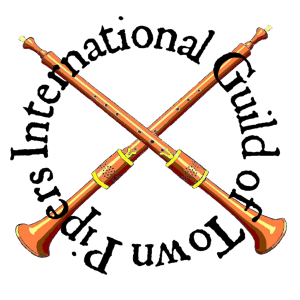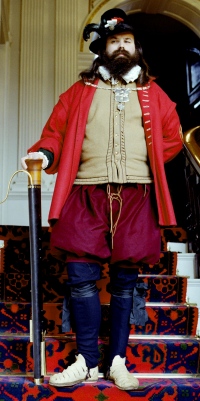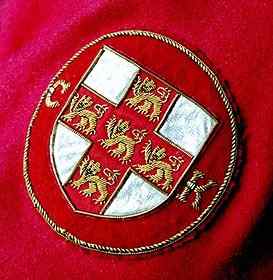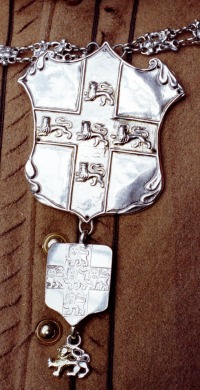The York Waits’ Chains
James Merryweather
First published in York Historian – vol. 20. Reproduced here by kind permission.
Summary The York civic regalia include three silver chains of office that were once part of the splendid uniform of the musicians of the city band, the waits. Today, the mace and sword bearers wear two of them on special occasions whilst the third remains redundant. The origins and early history of the chains are not known, but attention to detail of the city records and the chains themselves has revealed more about them than was previously understood.
THE WAITS
The waits (waytes, wates, waites etc.) were the civic musicians of most towns and cities in Britain (Figure 1). They also had their equivalents in Europe: stadtpfeiffers in Germany, stadspijpers in the Netherlands, pifferi in Italy etc. They appeared in the fourteenth and fifteenth centuries, and continued to serve until the first decades of the nineteenth. The waits were, therefore, well known in their localities and an essential feature in the daily life of their towns, playing music for grand civic occasions by the command of the mayor and corporation, going about their night watch duties, particularly during the winter, and entertaining the people.
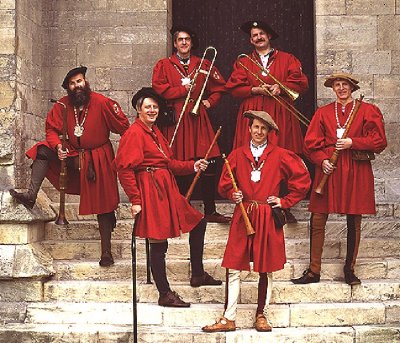
Figure 1.
The York Waits wearing scarlet livery and replicas of the York cognizances.
They were uniformed at the town’s expense and each was provided with a cognizance¹, an extravagant chain of office or badge such as those which have survived in York, as well as in Alnwick, Beverley, Bristol, Exeter, King’s Lynn (chains and badges), Leeds, Leicester, Lincoln, Norwich, Stamford (badges), and Wakefield. Of those that are now lost, some may have been stolen² and many were sold with other redundant regalia in the wake of the 1835 Municipal Corporations Reform Act, the act that abolished the waits themselves. Assuming they were not melted down, some may yet come to light if they are ever recognised by their present owners or astute enthusiasts.
Much more can be learned about the waits in general on this website3 and about the York Waits in particular in York Music4 and its update5.
THE YORK COGNIZANCES
(please refer to the records set out chronologically below)
Three York waits’ cognizances are extant, kept at York Mansion House (Figure 2). From their overall design characteristics, they seem to be of early Tudor manufacture. The earliest certain reference to the chains as we know them today is in 1565 when one of them is described in detail in a council chamberlains’ account book. However, there are references to waits’ silver chains and collars before that date and an intriguing mention of “a coler” as early as 1505. It is difficult to determine whether or not this collar, a term often used to refer to waits’ chains in other towns and cities, was one of our chains or an earlier chain. There is also no way of knowing whether it was a chain alone or if it had a silver shield attached to it as was evidently true from 1565, and may have been so several decades earlier.
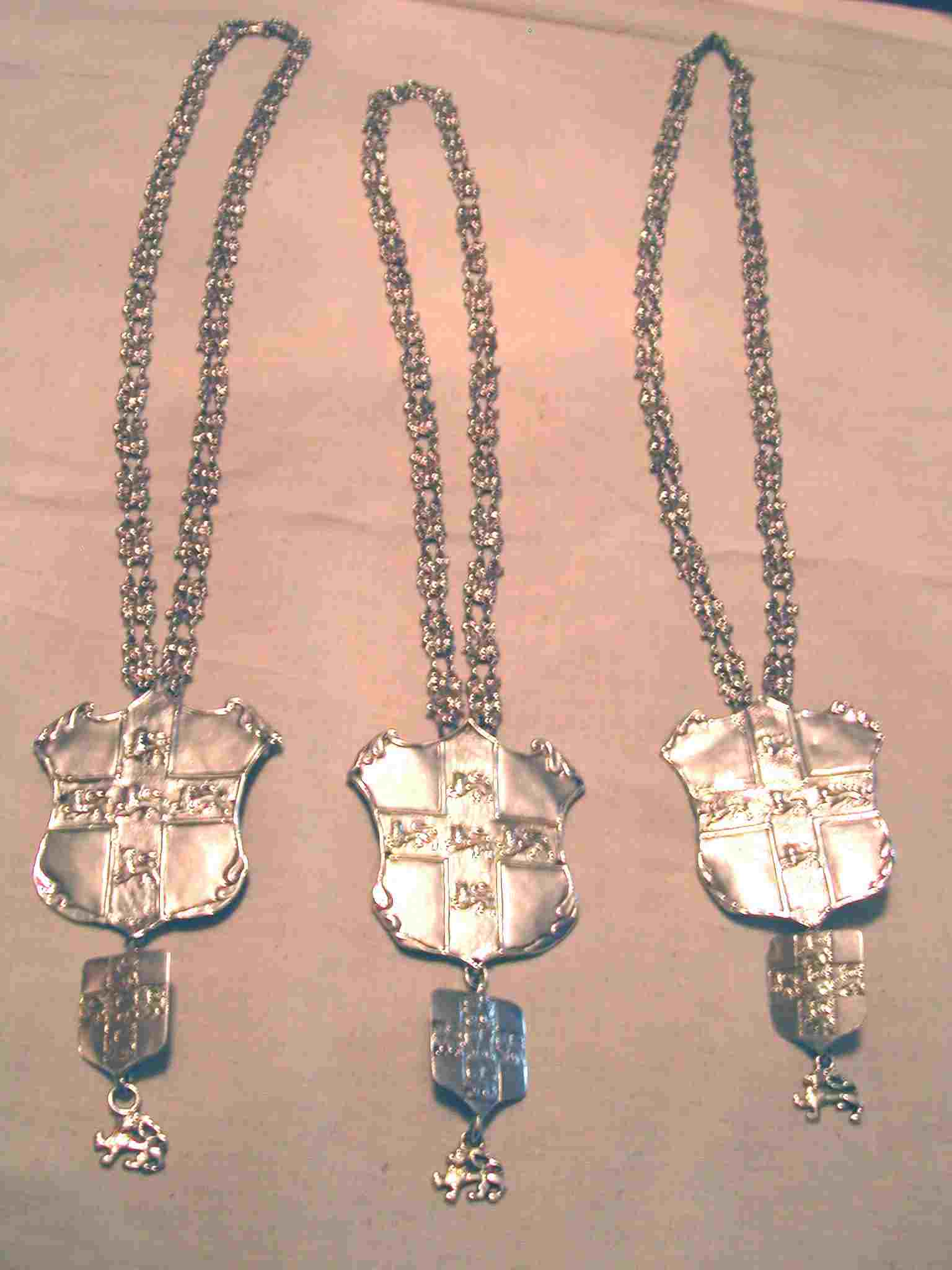
Figure 2.
The extant York waits’ cognizances.
At first there were three chains, until 1566 when a fourth was made to accommodate an additional wait. The manufacture of a fifth was recorded in 15936. There were six waits during much of the seventeenth century, but no record of a sixth chain has been found. Paradoxically, a fifth chain was again made in 17707.
Two of the waits chains are still in use (MHR12 and MHR13), worn on civic occasions in York by the Mace and Sword Bearers8. It is said that the “Porter”, who was the Staff Bearer, formerly wore the third9.
Each chain is made up of linked leopards10 (Figure 3) facing right with a silver shield bearing the arms of the city (St George’s cross – red on a white background – with five leopards, (Figure 4). Beneath each large shield is a smaller silver shield, also with the city arms, attached to the bottom of the larger and, attached to that, a single pendant leopard, this facing left.

Figure 3.
The leopard in heraldry.
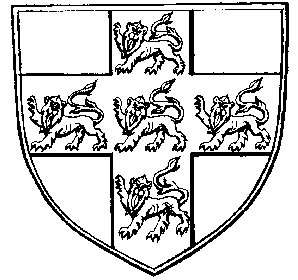
Figure 4.
The arms of York.
The leopards of the chains were cast in silver. They are joined to each other by S-shaped silver wire links and to their shields by rather crudely fashioned soldered wire loops. The larger shields or scutcheons11 (Figure 5) are of beaten sheet silver and the reverse sides are consequently concave. Some evidence of gilding remains in the deeper concavities in the reverse of the scutcheons, but most has been worn away by centuries of polishing. Each has a hook soldered to it behind so that it may be hitched up on the front of the coat. The smaller shields are thicker than the larger ones and their decoration was engraved.
Figure 5.
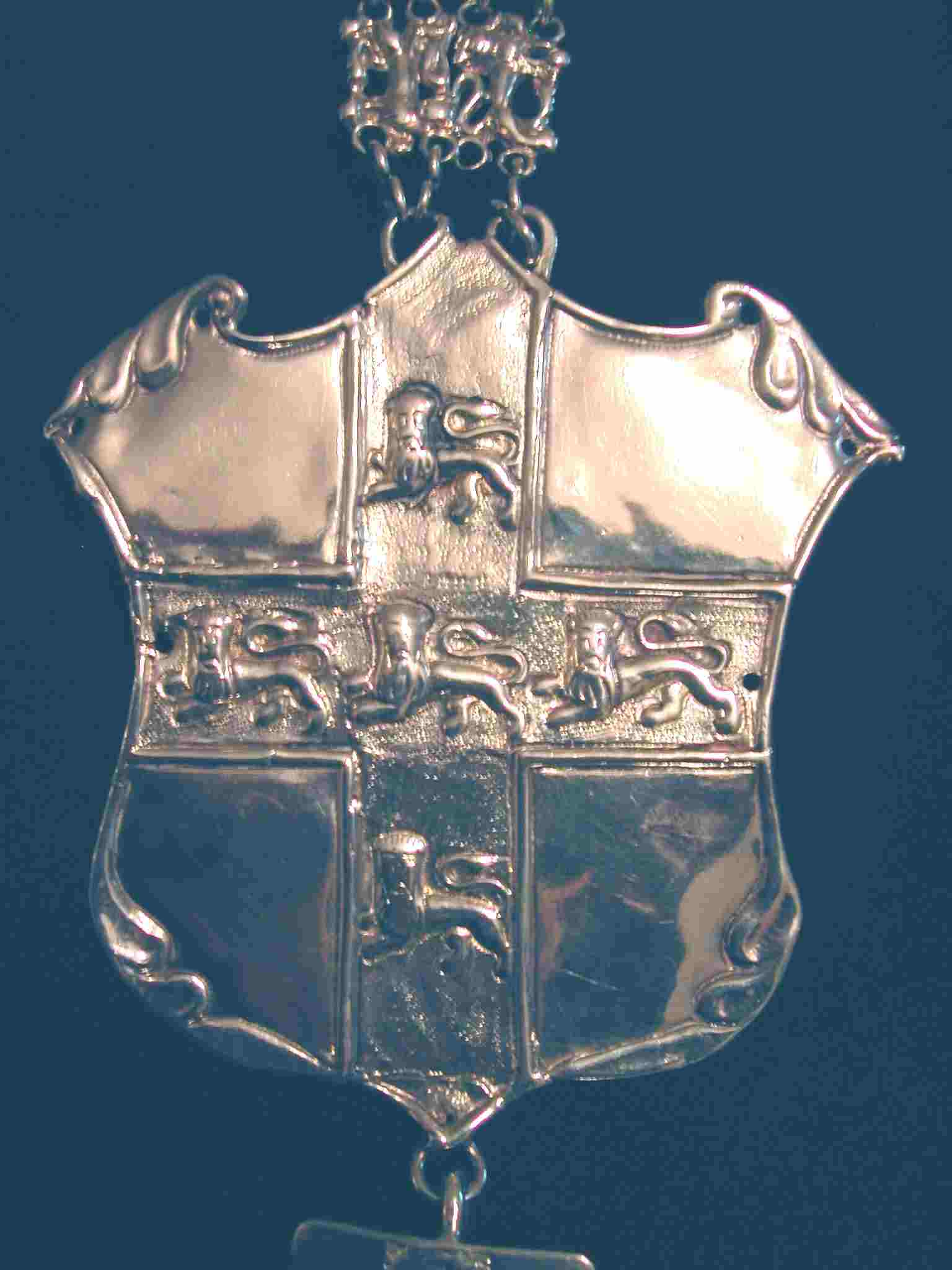
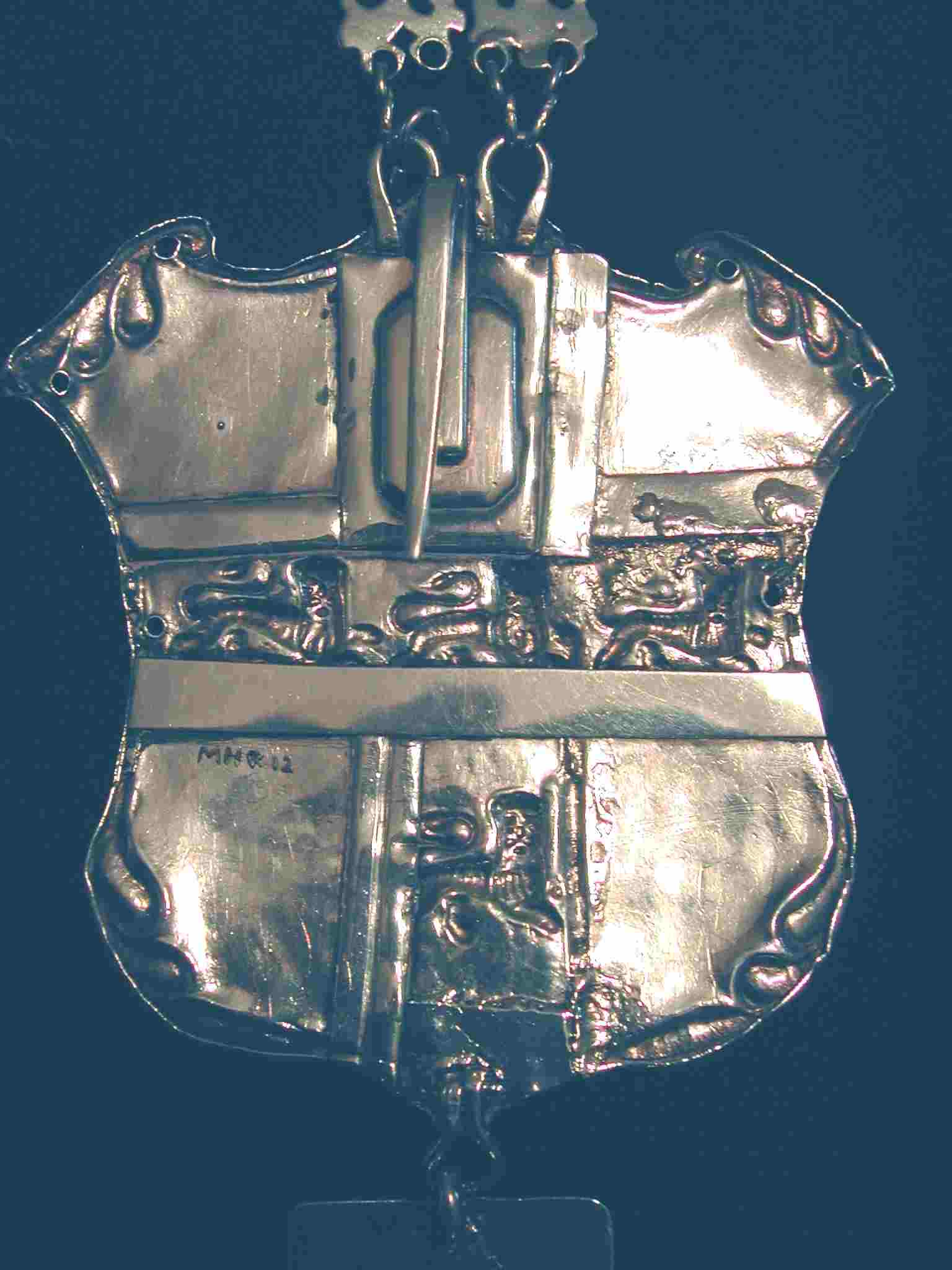
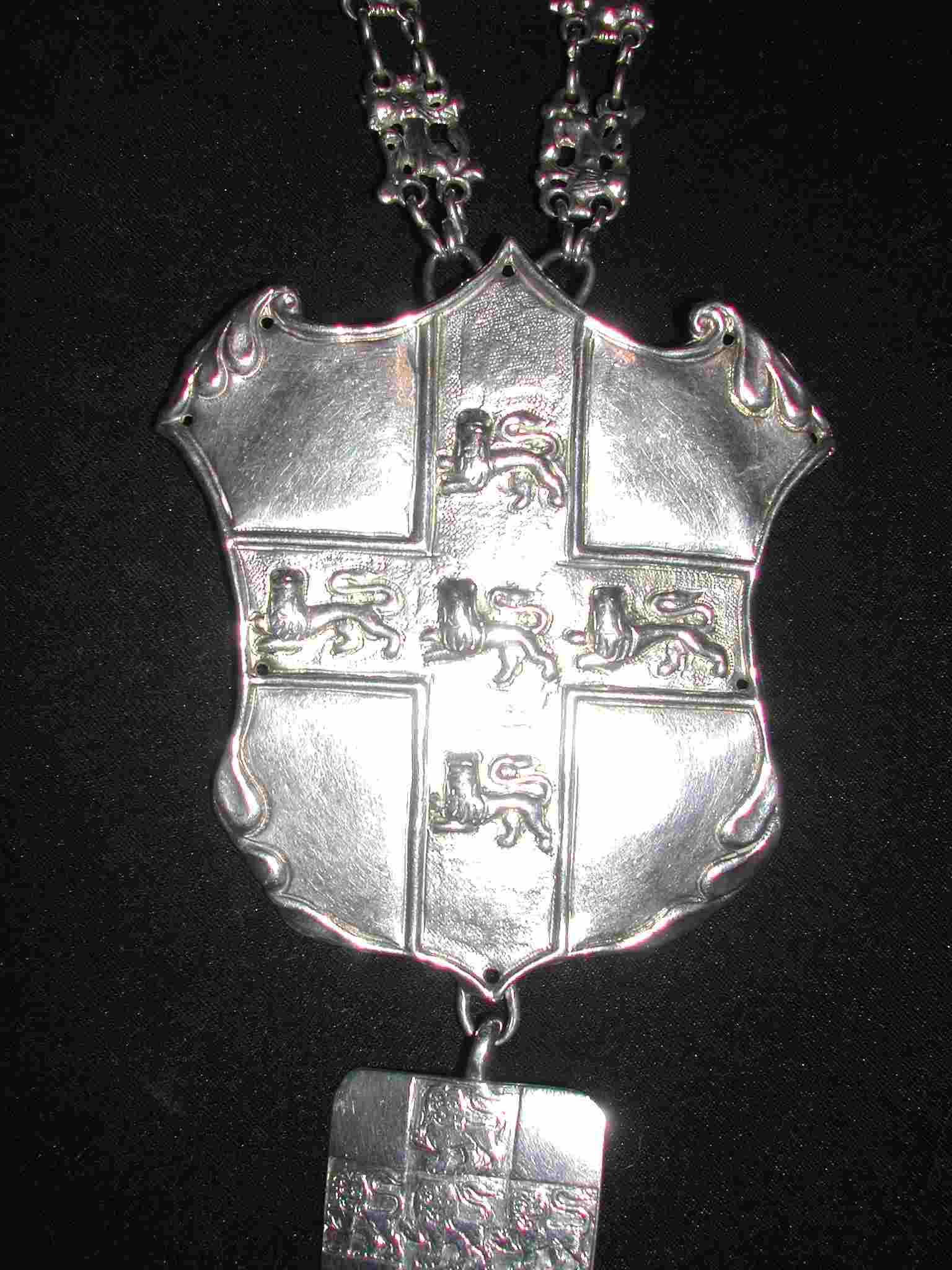
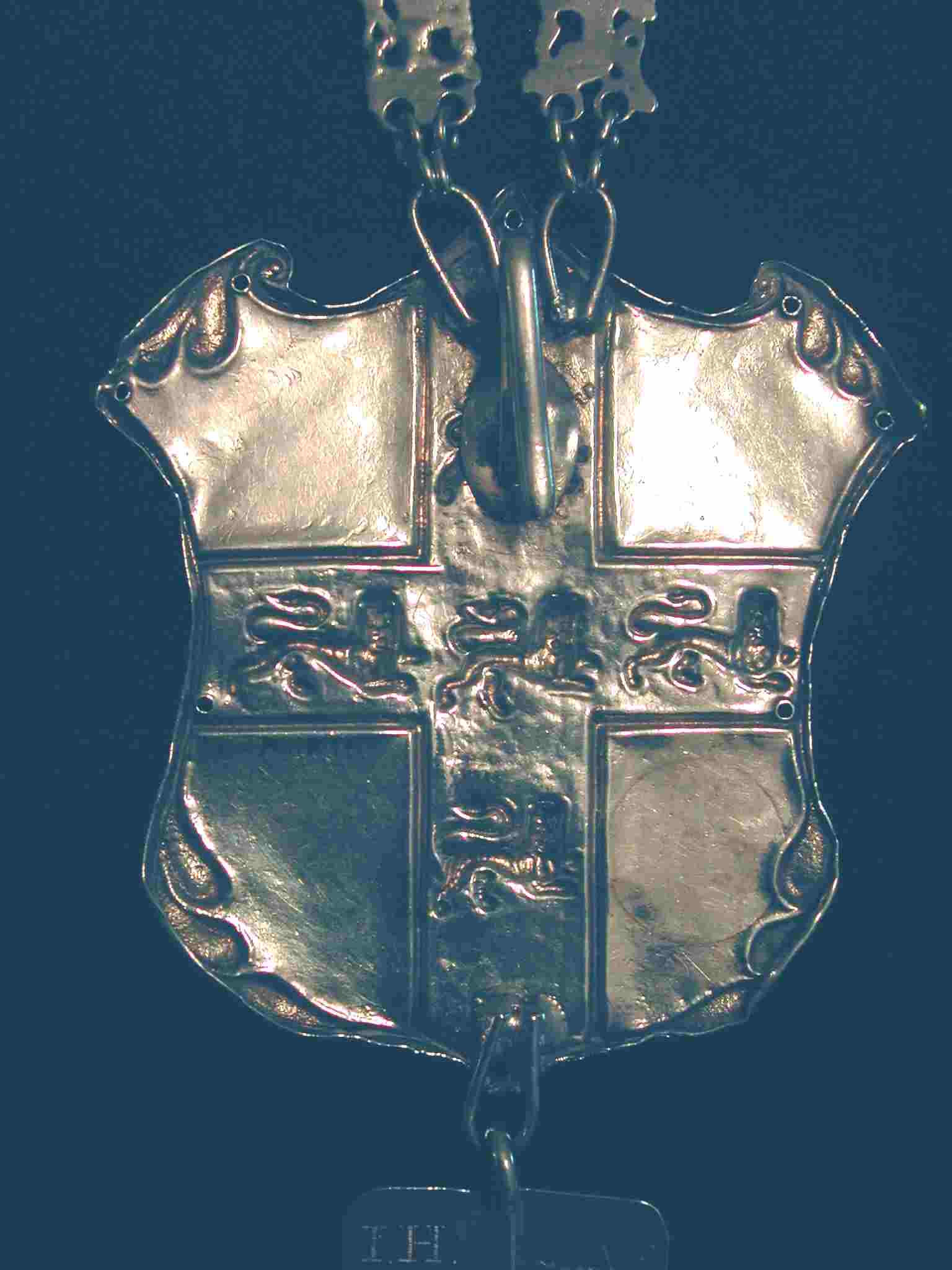
MHR12 obverse & reverse MHR13 obverse & reverse.
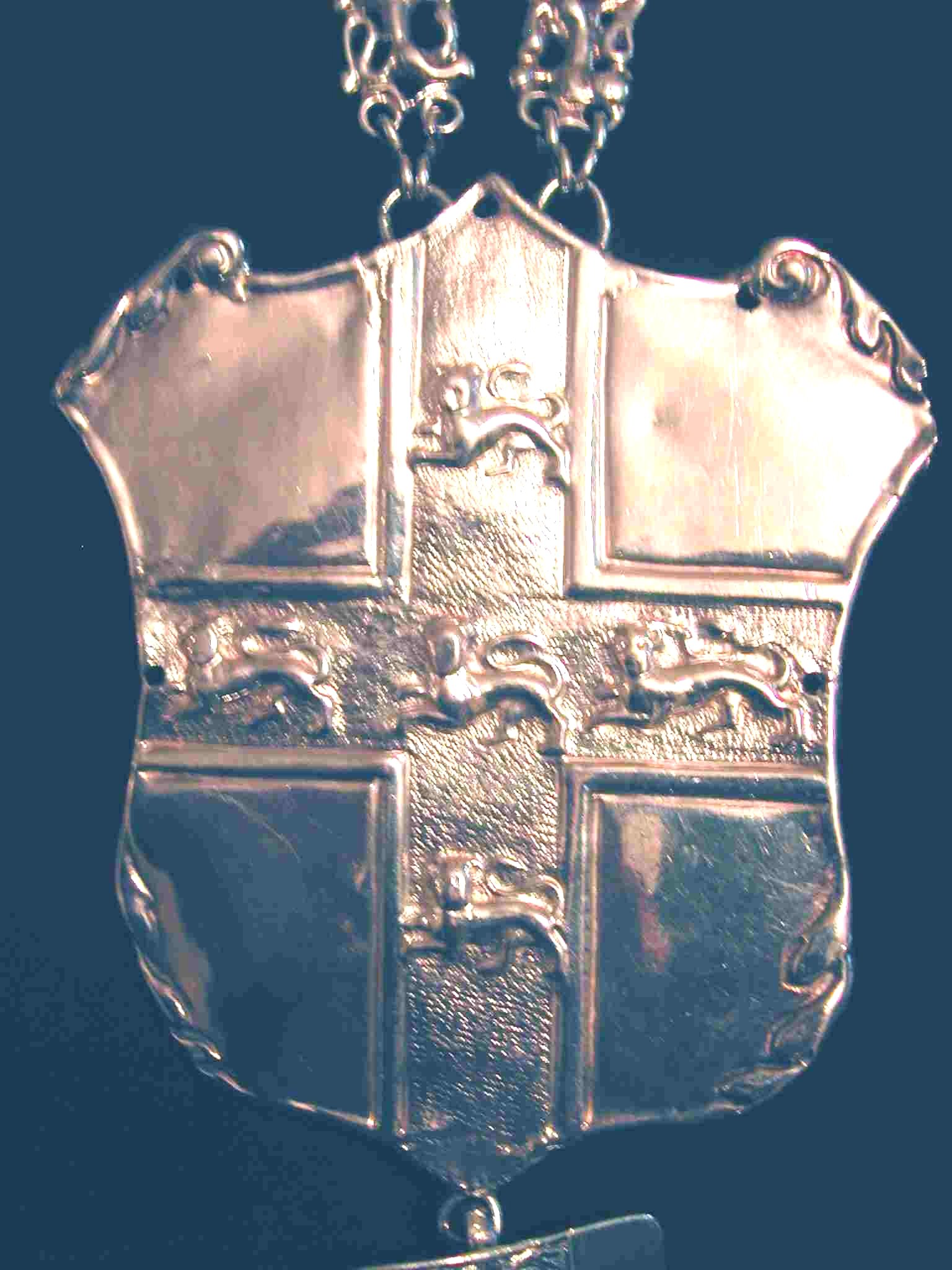
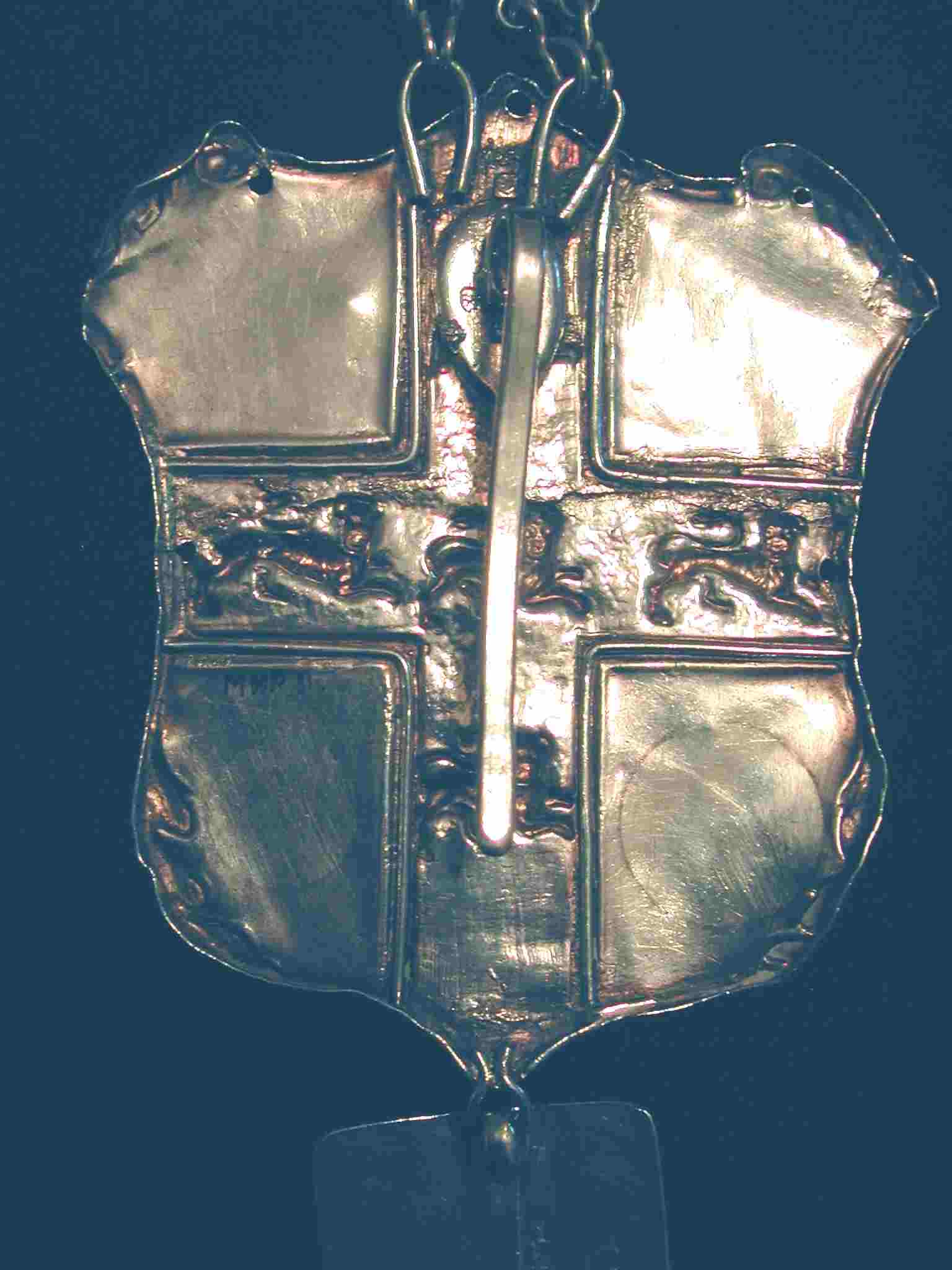
MHR14 obverse & reverse
The three chains are not identical and what similarities there are, are not reflected in all the components of each. They might have been have been dismantled and reassembled in alternative configurations from time to time. Thus, the larger shield on MHR12 is different from those on MHR13 and MHR1412 whilst the smaller shield on MHR13 is different from those on MHR12 and MHR1413.
DESCRIPTIONS
1. MHR12 has 33 links in the chain (34, Jewett & Hope14). The large shield is subtly different from the other two15. Four bands of silver are soldered in various positions across the reverse of the large shield, not to repair breaks (of which there are no signs on the obverse), but perhaps to prevent imminent breakages. There is a further repair to the point where the smaller shield is attached, and this piece was probably broken off at some time. Singularly, the reverse of this shield has an inscription engraved in minute dots in the upper, right-hand quadrant (Figure 6). Although at first sight initials appear to be “H.B.” microscopic examination has revealed a third full stop between the uprights of the proposed “H”. Therefore, the initials may be “J.C.B.” but it is not known to whom they belonged.
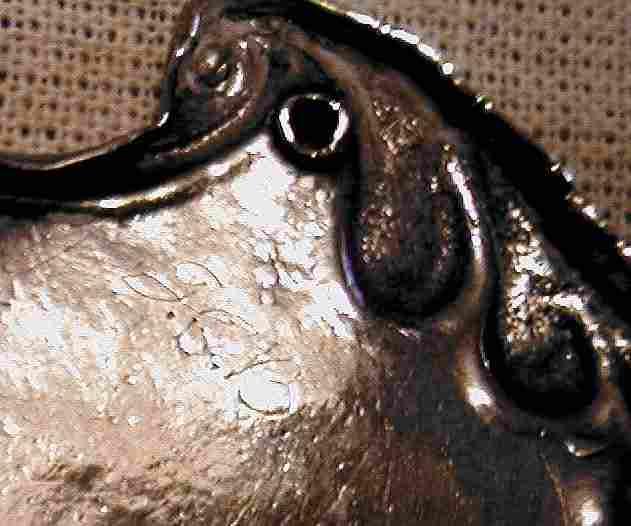
Figure 6.
Initials engraved on the reverse of MHR 12.
The smaller shield (Figure 7) is a pair with that on MHR14 and its reverse is engraved “W T” and “I G”. It seems logical that these initials should belong to the wait who had paid his surety on the cognizance. Therefore, these can only be the initials of William Tireman (wait 1703-1761) and John Girdler (wait 1623-1666)16.
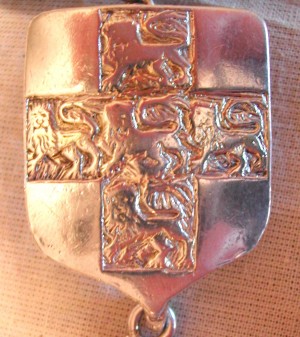
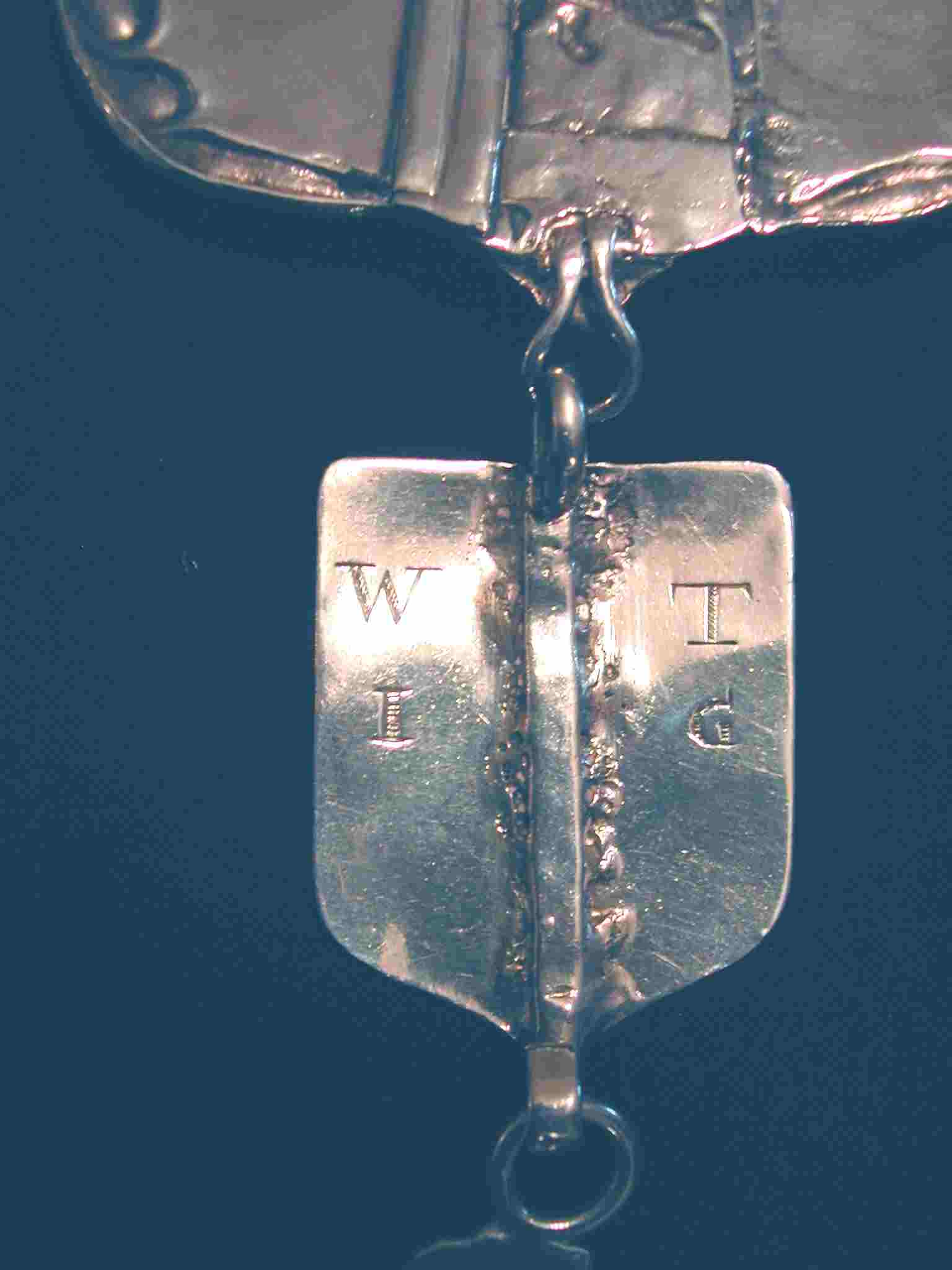
Figure 7.
Small shield on MHR12, obverse and reverse.
2. MHR13 has 30 links in the chain (32, Jewett & Hope17). As asserted above, the larger shield seems to be one of a pair with that on MHR1418.
The smaller shield (Figure 8) is, however, different from those on the other two chains, both in shape and the design of the city arms. It is less worn and looks newer. The appearance of the leopards is very different and they have an almost comical look on their faces. The reverse is engraved “I.H. JANy. 1822″. These are certainly the initials of John Hardman who was appointed wait in 182219.
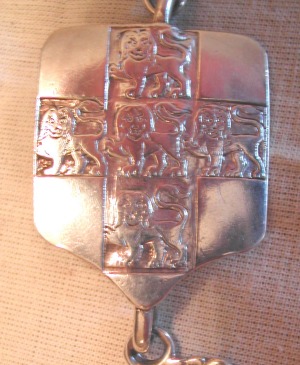
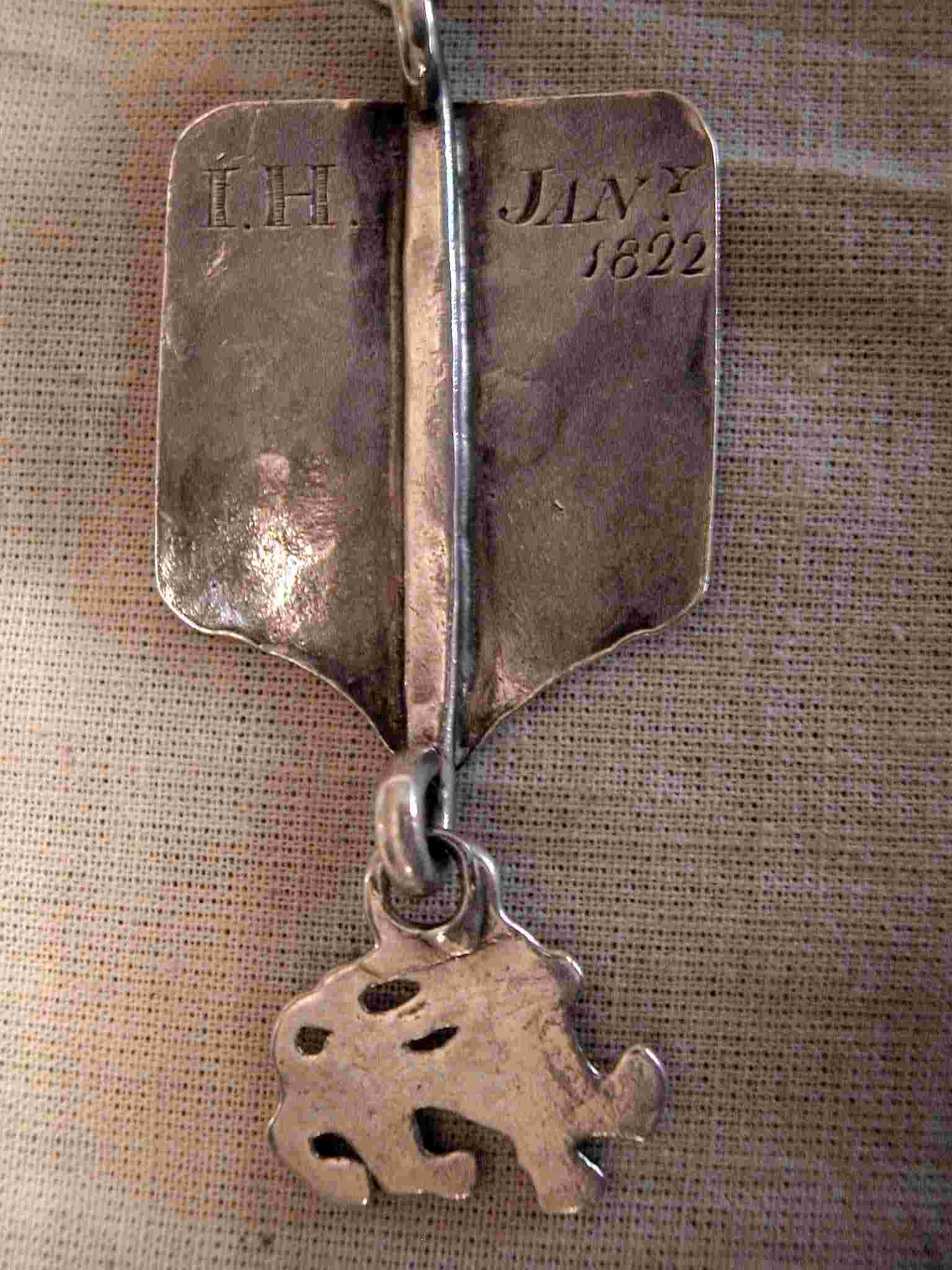
Figure 8.
Small shield on MHR13, obverse and reverse.
3. MHR14 has 34 links in the chain (35, Jewett & Hope20). The larger shield seems to be the pair of that on MHR13, although it is narrower, perhaps due to some reworking of its edges.
The smaller shield (Figure 9) is very similar to that on MHR12 and the reverse is engraved “T G”. Again, these can only be the initials of one of the waits, in this instance Thomas Girdler (wait 1630-?164021). It is possible to detect a similarity between the shape of “G” in “I G” and “T G” which might tempt one to conclude that they are contemporary: the Girdlers were brothers. However, it should be noted that both examples of “G” are not very different from the “G” in this text! What is significant is that the initials of the two Girdlers were engraved centrally, perhaps a further indication that they are contemporary, and forcing “W T” to be placed above “I G” when inscribed later, in the eighteenth century.
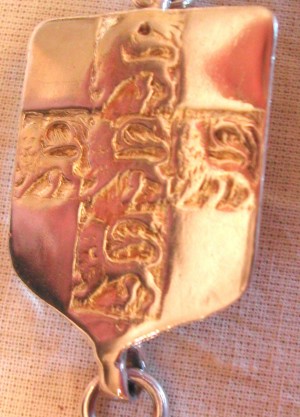
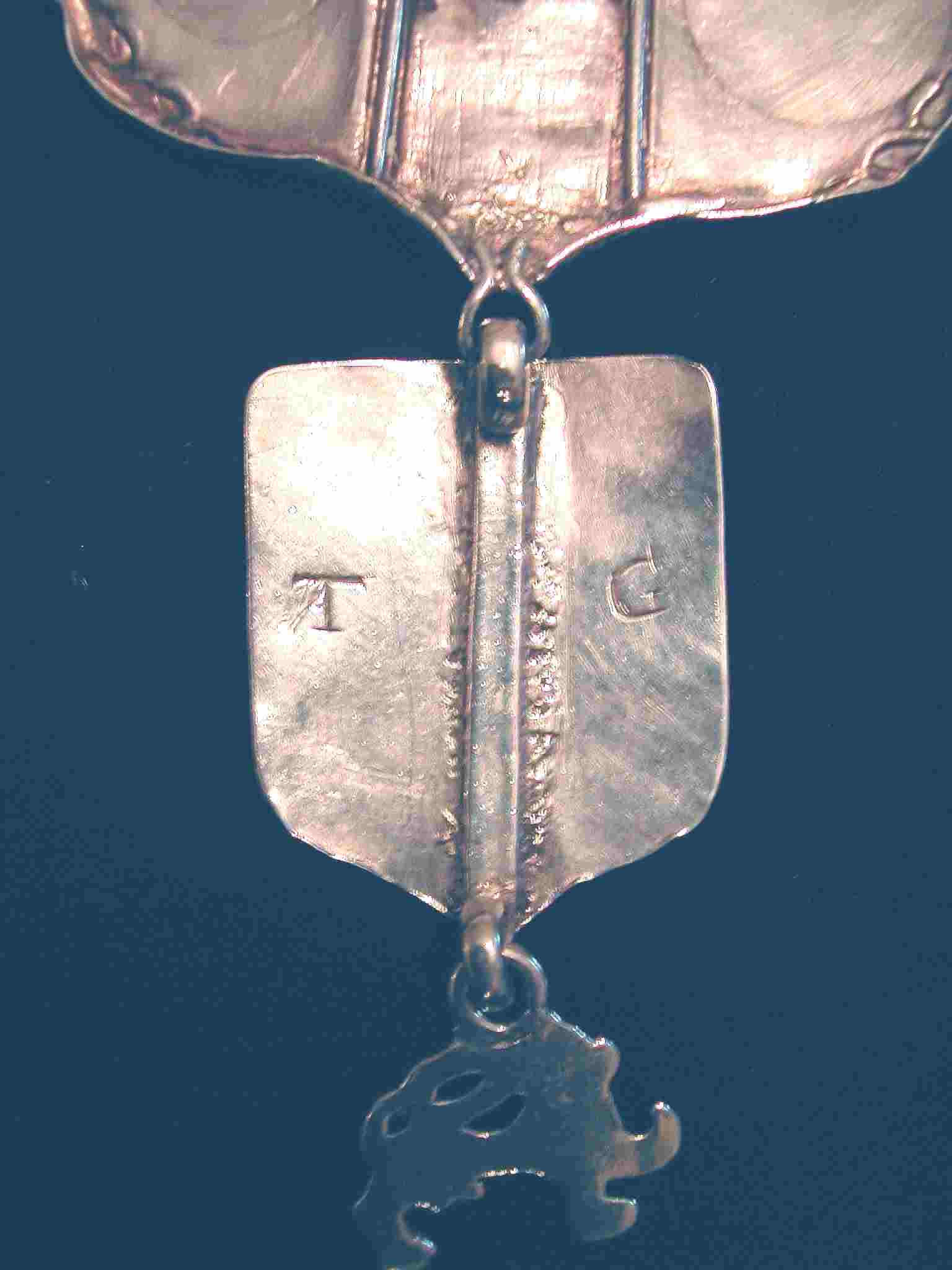
Figure 9.
Small shield on MHR14, obverse and reverse.
THE RECORDS
All records relating to the York waits’ cognizances are quoted, with source detail, notes, discussion and the author’s interpretation. Sources are abbreviated as initials thus: (J&R)22, (W)23, (J&H)24 and (M)25.
1505 (15 Jan) House Book 9 f 2126
Assembled in Þe Counseill Chambre within Þe Comon Hall My lord Maier showed how Þat one Roger Smalwod Mynstrall whiche is come to occupye as one of Þe Mynstralles of Þe Citie & is Knawen right connyng & of his awn cost for Þe wurship of Þis Citie hase maid hym a coler to his gret charge etc. (J&R)
It is dangerous to conclude that this is the first mention of any of the waits’ chains recorded later or the extant examples, for it only says that Roger Smalwod made (or, rather, had made for him at his own expense) his own collar. Collar, however, can confidently be taken to mean a chain of office (see 1565 below). Smalwod appears to have been new to York, perhaps previously a wait in a town where, like Beverley, waits already had chains.27
1520 Chamberlains’ Book 2, f 33
It’ pd to Thoms Baker vestmentmaker for the brodering of the waytes sleyves wt the armes of the City vj s viij d (W)
The City arms were embroidered onto the waits’ coat sleeves until 1535 when they were produced as a separate embroidered badge. There is no mention of the silver chains under discussion until 1557.1521 Chamberlains’ Book 2, f 69v
Itm pd to stephyn Whynfell vestmentmaker for brod’yng of ye waites slefes wt armez of ye City v s viij d (W)
Cognizance embroidered on the coat sleeve.1522 Chamberlains’ Book 2, f 113
It pd to stephyn whynfeld vestmentmak’ for brod’yng of the waytes sleifes v s viij d (W)
Cognizance embroidered on the coat sleeve.1523 Chamberlains’ Book 2, f 158v
It pd’ to stephyn Whynfell vestmentmak’ for the brod’yng of ye wayte sleyfes v s viij d (W)
Cognizance embroidered on the coat sleeve.1524 Chamberlains’ Book 2, f 203
Itm pd to Thoms Baker vestmentmak’ for makyng <&> broderyng of the waytes sleif wt sylk <—-> wt the armes of this City & the <——–> v s VIIJ d (W)
Cognizance embroidered on the coat sleeve.1524-5 Chamberlains’ Book 2, f 203
Item paid to Thomas Dakyn vestmentmaker for makyng & broderyng of the waites slefes wt sylke & golde wt the armes of this City . . . . vj s viij d. (J&H)
Same entry as 1524 above but, although it is apparently more complete, is possibly less authoritative.
1520-4
A carving of five musicians on the Minstrels’ Pillar in St Mary’s Church, Beverley is installed28. Four of the figures are wearing waits’ chains with a scutcheon the same shape as that of York (Figure 10). Can they be the York waits? If so, this is the earliest indication of the existence of the York waits’ cognizances, although the first mention in the records is in 1557. It would confound any theory that might be proposed in their absence that before 1557 the waits wore only their embroidered sleeve badges.
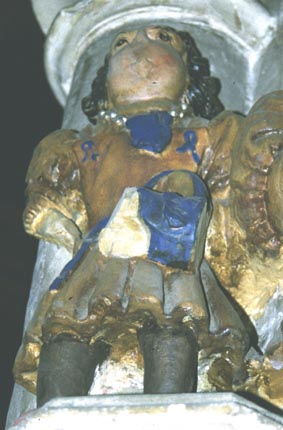
Figure 10.
One of the Beverley minstrels wearing a cognizance with York shaped scutcheon.
1525 Chamberlains’ Book 2, f 245v
Itm pd to herry fedd’ston vestmentmak’ for brod’yng of the waites sleiffes v s viij d (W)
Cognizance embroidered on the coat sleeve.1526 Chamberlains’ Book 3(1), p 78
Itm payd to Richard Bargh vestmentmaker for brod’yng of the wayt sleyff v s viij d (W)
Cognizance embroidered on the coat sleeve.1528 Chamberlains’ Book 3(1), p 78
It’ pd to Richard Bargh vestmentmak’ for brod’yng of the Waytes sleyffes wt the arms of this City v s viij d (W)
Cognizance embroidered on the coat sleeve.1535 Chamberlains’ Book 3(2), p 127
Itm payd to humfray Brerton & m’maduk Smyth broderers for makyng iiijor scutchons to the iiijor Comons Waytes of this Citye wt the lres [letters] of my lorde mayer nayme . . . . viij s. (W)
Embroidered badges, now with the initials of the Lord Mayor and perhaps separate for stitching on the sleeve (Figures 11 & 12). Four waits? There were not continually four until 1566. Perhaps one extra wait for a short period or the extra badge was made for an apprentice.1544 Chamberlains’ Roll c6:13 p 1
Itm payd to M’rmaduke Smyth vestmentmaker for the making of scutcyons to the three wayt of this City wt letts of gold for my lord Mayour name Accustomyd Ageynst Crystmas viij s. (J&R)
Embroidered badges.1547 Chamberlains’ Accounts c16:15 p 1
Itm payd to Marmaduke Smyth vestmentmaker for maiking of scutchons to the three wayt of this city with letts of gold for my Lord Mayour name accustomyd Ageynst Cristmas (J&R)
Embroidered badges1554-5 “and so again in 1554-5” (J&H)
|
Figure 11. |
Figure 12. |
1557 (25 June) House Book 22 f 67v
And now Robert Husthwait by this presens is to to be mete to remain one of the common waytes of this Citie vpon his good behaviour & dylygens. And aftr he be franchised the syluer cheyne with the skutcheon. apon surety to be delyuered and given by weight & tale prouyded that the resydew of the Aldermen & Counsell nowe absent be made ptyvey to the sayd admyttens And theyr consent to be haid to the same (J&R)
In this entry I have emboldened “the syluer cheyne with the skutcheon” throughout the phrase. This makes it suggest, as was recorded in 1565, that the scutcheon was attached to the chain. However, if the phrase is printed thus:”the syluer cheyne with the skutcheon” the meaning changes so that the two items are separate and “scutcheon” then might refer to one of the embroidered scutcheons which were recorded as having been worn annually since 1520; indeed, they continue to be made for a further four or more years. From 1557, they were accompanied by a chain of office. Therefore, this entry does not enable us to conclude, no matter how tempting it may be, that the waits’ chains had their silver shields at this date, but they certainly did eight years later, in 1565. return to discussion
1559 Chamberlains’ Book 5(1), f 53v
Item payd to vxor Marmaduke Smyth Broddr for makyng the Skutchon of this Cittie Armes for the Thre waytes of this Cittie with the letteres of gold threyd for my lorde Mayor name accustomed agaynst Crystynmes viij s (W)
Embroidered badges.1561 Chamberlains’ Roll c7:1
Item to Iohn Atkynsone embroderar for makyng Scutchoons of the armes of this Citie to the said three waytes of the same wt lettres for my Lord mayour name (P.C. = Parcyvall Craforth). (J&R)
Embroidered badges.
1565 Chamberlains’ Book 5(2) p 2
Collers of Sylvere delyverd by Mr John Bean Mayor the vijth of decembre aº 1565 to the waites of this Citie (W)
Sixty years after the previous mention of “a coler”, here are silver collars, and they are the property of the city. There were certainly three collars as the following year a fourth was ordered. Three is entirely consistent with the number of waits to this date from when waits also can first be identified by that name in the records: “trium ministrallorum ciuitatis” (1433) and “lez Waytes ciuitatis” (1434).
1565 Chamberlains’ Book 5(2) p 2
Arthure hodshon, One Coller of xxxviij [38] Libortes wth Tryangles & a Libart pendent weyng iiijor vnces a quartron & di [demi] quartron to be delyvered in agayn whan the same shall be callyd for and Surtys for the same Trestram ffordam Tayllor & Rychard Bakes marryner. (W; J&H)
This remarkably full description shows that a “collar” is made up of linked leopards (ditto 1593), that is a chain, and by 1565 at the earliest, silver badges hung from those chains or collars. Better still, “Tryangles & a Libart pendent” confirms that the additional small shield and leopard are of greater antiquity than previously thought, indeed dating from 1565 at the latest. Unfortunately the page is torn so that the description of only one of the chains has survived.
1566 (30 Oct) House Book 24 f 57
the comon wayt of this citie for their mysdemeano are dischardged of their office And have psently deliuered in their Sylvar Collers to the Chamberlaynes and one Shalme. (J&R)
See discussion for 1565.
1566 (19 Nov) House Book 24 f 58
there shalbe contynewally ffoure waytes And the iiijth wayte to haue suche ffees & lyverie of the Chambre with Cognisans as thither iij haue ben accustomed to haue And alsoo a newe Syluer Cheyne aggreable with thither iij cheynes to be made ageynst Christmas by discrecion of my lord mayour and deluered to such of the sayd wayte as his Lordship shall seme good. (J&R)
Cognizance and chain are separate items in this entry. See the following entry: it seems that, in the mid 16th century, the waits wore both embroidered badge and chain of office.
1571 (12 Dec) House Book 24 f 267
Arthure Hogeson Apprentice shall haue a Cote of the Citie Chardges, and to weare one of the foure badges and one of the iiijor Cheynes belonging to the Citie waites etc. (J&R)
Cognizance and chain are separate items in this entry.
1572 (20 Oct) House Book 25 f 24
And nowe it was agreed by theis presens that for certayne consideracions the Waites of this Citie shalbe called in and their Cheynes Cognysances to be taken from them and not to serue as Waites of this Citie. (J&R)
There is a word missing in this entry. Did the clerk mean “Cheynesof Cognysance” or “Cheynes and Cognysances”? Since he has bothered to end the word “Cognysances” with an “s” we might presume the latter. The waits had been sacked, but on this occasion, unlike several others of note, their misdemeanour was omitted from the records. They were back in service again in 1576.
1583 (3 Feb) House Book 28, f 90
And now Mr Willm Robinson Alderman brought in & deliued before these psens a coller & a cheyn of Silvar for one of the wates of this cyttie wch cheyn was now deliud to thandes of henry Wilkinson one of the chamberlanes (W)
This entry is most perplexing for it seems to at first refer to separate items which have been presumed elsewhere in this discussion to be synonymous. The second mention, “wch cheyn”, evidently refers to the whole item. Did the clerk simply double his description or did the chains have a backing collar of some sort, as is occasionally seen today? There is no suggestion of this elsewhere in the York records.
The chain had been delivered up because Arthur Hodgeson died, some time early in 1579. This seems a little late, but the records show that he was still receiving his livery and payment in 1581. This may have been the equivalent of a pension for Mrs Hodgeson as it was customary for a wait’s widow to have his coat cloth, at least for a while after his death. From November, 1580 Thomas Moore, Iohn Bawderstone and Iohn Clerke continued to work as three waits and the band returned to four in 1583 below.
1583 (4 May) House Book 28 f 137v
It is agreed that one George Coper Cowper late of ipswiche shalbe a wate of this Cyttie vpon his good behuiour during the pleasure of the lord maior & aldermen of this cyttie vpon securitie for deuery of his chaine (J&R)
George Cowper will have received Hodgeson’s chain.
1584 (31 Oct) House Book 28 f 159
John Clarke and Baltherston two of the waites of this cittie . . . .dischardged of the said office of wates, and their badges to be taken from them etc. (J&R)
No mention of the chains. Were the cognizances simply being given the more general appellation of “badges” on this occasion? It would certainly be more important for the council to recover the silver chains than worry about ephemeral embroidered badges.
1585 (17 Feb) House Book 29 f 3v
And nowe Thomas Turner Goldsmithe dyd exhibitt a bill for newe flourishinge and trimminge of the Scutchons and Chynes belonginge to the iiijor waytes of this Cittie amountinge to the Some of xxix s iiij d (J&R)
Turner the Goldsmith would hardly be required to deal with the product of an embroiderer, so the “scutcheons” of this reference must be silver shields attached to the chains. Since the following Chamberlains’ accounts entry 11 April contains the term “foure collours with skutchions” it seems reasonable to conclude that in this entry “Scutchons and Chynes” means scutcheons attached to chains.
1585 Chamberlains’ Book 6(1)
Paid to Thomas turner goldesmyth for makinge thre skutchons for the waites collers vij s to hym for makinge & amendinge of the iiijor cheines – vj s viij d Item for mendinge iiij conysnces & gildinge the reast viij s. Item more for one once and a half of sylver to the same vij s iiij d. Som – xxvij s. (W; J&H).
“for makinge” three scutcheons? The House Book entry above goes no further than to record “newe flourishinge and trimminge” not manufacture. In this entry, the word “makinge” was probably a casualty of the chamberlains’ clerk’s use of English. Anyway, Turner only used 1½ ounces of silver, not enough to do more than repair existing silverwork. However, here is proof that the chains were, at certain times, gilded (see also 1603 & 1639). This repair and gilding exercise (see next entry) would have been preparation for that year’s Mydsomer even show29. There are consequent examples of tidying and regilding the waits’ chains for special, Royal, occasions in 1603 and 1639.
1585 (11 April) Chamberlains’ Book cc6(1) f 1v
Delyverid to the said Robert hewite foure collours with skutchions and foure connysayntes & whereof one of the collers haith xliij xlv [45] lybartes besydes the skutchion And one other hath xxxvi xlvi [46] lybertes besydes the skutchion And one other hath xlvjti [41] lybartes besydes the skutchion And one other of forty five [45] lybartes besydes the skutchion which said foure collers connysantes and skutchions doth weigh all together forty Twenty and seaven ounces etc. (J&R)
In this entry the collars have scutcheons attached to chains and are separate items from cognizances (which we may presume refers to embroidered badges). From this there can be little doubt that “collers connysantes and skutchions” refers to a chain of linked leopards, each with a silver shield (and lesser shield and leopard) attached.
1588 Chamberlains’ Book 6(3), f 1
A scottson & a coller of Jo balderstons dd [delivered] in by the waites 3º die Augustij 1588 (W)
Does this mean a chain with scutcheon or are chains with scutcheons and embroidered scutcheons still in use together?
1592 (7 April) House Book 30 f 315v
And nowe it is agreed that Iohn Watson Musicione Shalbe one of the common waites of this Cittie in the place of Christofer dent disceased, And that my Lord Maior Shall deliuer to him the Silver Cheyne and Scutchion vpon sufficient sureties for redliueriye theirof & as haith bene accustomed. (J&R)
It is impossible to say whether or not the scutcheon was attached to or separate from the chain.
1593 (8 Aug) House Book 31 f 22v
Also it is agreed, That christofer Smithe & Cuthbert Thompson shalbe two waites of this Cyttie, And that thone of them shall haue the Cheyne and Conysent which is alredye made & either of them a newe cote forthwith, And that a new Conisent shalbe forthwith made for thother of them and a new Cheyne about Allhallowmass or christenmas when money Cometh in, they puttinge in suretyes for redelyverye of the sayd Conysantes and Cheynes as hath bein accustomed. (J&R)
It is not always possible to trust a clerk’s grammar, but this entry does state: “the Cheyne and Conysent is alredye made”, not are, it seems therefore, referring as in 1585 and 1592 above to the complete chain with shield. However, it goes on to speak of “a new Conisent shalbe forthwith made for thother of them and a new Cheyne” which shows them to be separate items. NB that the bold type is my addition and that emboldening “and” could change the meaning of “Cheyne and Conysent” and “Conysantes and Cheynes” to suit my interpretation. This entry leaves me undecided whether or not the clerk was describing chains and cognizances or chains with cognizances. However, there is plenty of evidence that by 1557 the silver shields had been attached to the chains. It is probable that the waits were receiving a silver chain with scutcheon and a badge.
1593 (14 Sept) House Book 31 f 27v
Also it is agreed that the Chamberlains shall pay to William pearson gouldsmythe viij s for renewing fower of the Conysantes for the Waites & also v s more which he hath putt into the same fower Conisantes. (J&R)
No clues except that an embroiderer was not involved, so “Conysantes” probably means silver chain and shield again. I think it is fair to presume, from the lack of strong evidence to the contrary after this date, that the embroidered badges were discontinued at or around this date. From now on the chain consisted of chain and dependent scutcheon(s). From this point the “&” between the two items will be emboldened to show probable association, but the jury is still out!
1593 Chamberlains’ Book 7(2), f 72v
[among other items listed as passed to the new Chamberlains] 2 lybertes for the waites coller (W)
1593 Chamberlains’ Book 7(2), f 75v
15 Sept’ 1593 jac John Watson musition surety for Cuthbt Thompson for his conisant (W)
1602 (7 May) House Book 32 f 200v
Cuthberte Thompson late one of the waites . . . . having already befor his departure given up his Cheyne & Conysant etc. (J&R)
The eternal problem: whether or not the cognizance, shield or scutcheon was attached to the chain – presumed: probably.
1603 Chamberlains’ Book 11(2), f 59v
Item to wm hutchenso for mending the litle mace xij d
Item to hym for mendyng & gilding of the cheyns ij s vj d (W)
Gilded for the Royal visit of James I & VI, 16-17 April, 1603.
1603 Chamberlains’ Book 11(2), f 87
It to wm hutchenson goldsmyth for mending ij of the & gilding ij of the Waites chynes ij s vj d (W)
1623 (5 Feb) House Book 34, f 262
And now ffrances Bradley widowe late wief of Richard Bradley late one of the Waites of this Cittie desceased hath delued in open Court the Cheyn & scutchion wch her late husband had It is therfore agreed that she shall have her husband bond deliud her wch was entred for the saif redelivery therof. (W)
By this date, I think it is established that the chain consisted of chain and scutcheon, or rather, since that was already clearly described in 1565, that the embroidered badges had been phased out, I should hazard in 1593 when the number of waits increased from four to five.
1623 (17 Feb) House Book 34 f 262
And nowe John Girdler was Chosen by thes presentes to be one of the waites of this Cittie in place of Iohn Watson . . . . And the saide Iohn Girdler is to enter bond to this Corporacion with sureties for the redeliuery of the Sackbut & Cheyne of siluer, at his departeinge from the said place, displaceinge or death which shall first happen for to be. (J&R)
Shield not mentioned, but since the three extant examples each have a shield it must have been present since before 1565 (except that NB one of the present York Waits insists on wearing his chain with the shield removed. However, his reason for doing this is not understood by his fellow waits).
1623 (14 Nov) House Book 34, f 275v
And wheras Edward Easton is comended to be A very skilful musition It is agreed by thes prentes that he shalbe one of the waites in this Citty in place of Richard Bradley disceased And that he shall paie for his freedome of this Citty as Richard Bradley paide for his freedome And that xpor [Christopher] Thompson and John Girdler waites ther bondes shalbe takne as suerties for hym for the Chayn & Skutcheon (W)
1639 House Book 36 f 21v
And that the waytes of this Cittie play vpon Micklgate barr and on Bowthomebarr at his Maiesties Coming into the Cittie and passing through the Mannour and if need bee that their cognizances bee new burnished. (J&R)
Probably repairs, cleaning and, perhaps gilding as in 14 Sept 1593. Preparation for a special occasion, as in 1585 and 1603, this time a Royal visit by Charles I.
1660 (28 Nov) House Book 37, f 144
Ordered that when the waites of this Citty make vpp their Compleat number of six according to a former Order of this Court that then their Sallary for liueries shall bee taken into Consideracion prouided alsoe that John Girdler & ye rest of ye waites doe deliuer their Chaines and badges to their Sucessors in that Office as this Court shall order. (J&H)
Apart from another welcome mention of the waits’ chains (“chaines and badges” is presumed to refer to chain plus scutcheon) this is a new piece of information relating to the seventeenth century waits. The end of John Girdler’s dynasty was a mystery, presumed to have occurred in 1666 when he died, probably of plague.
1693 (24 Oct) House Book 39, f 69v
. . . . . And they were ordered forthwith to bring their badges and liveries belongs the City & deliver them unto the Lord Mayor. (M)
The term “badges” is not helpful.
1770 (8 Feb) House Book
Agreed that a Chain and Shield be printed for the fifth City waite, the Commons consenting. (M)
A clear reference to the complete chain and shield. Why the new chain is described as the fifth is a mystery because there should already have been five chains, or more probably six, at this time.
DISCUSSION
The first reference to a wait’s cognizance in York records is the collar made by, or more likely, made for a new wait, Roger Smalwod in 1505. Exceptionally, he paid for it himself and the expense was apparently considerable: “of his awn cost . . . . to his gret charge”. This record should be treated with great caution and it is my intention to let it stand alone as no more than the mention of a collar unless further contemporary material comes to light. There is nothing to suggest that it was not a “home-made” collar, or the first of the waits’ chains to be made or, indeed, whether it is one of the waits’ chains kept at York Mansion House today. Research to date gives us no reason to believe that it was the custom for waits to pay for their own cognizances, they being usually the property of the civic authorities that employed the waits. However, one other occurrence of this sort has recently come to light, in the city of Oxford. In 1588 William Gibbons and George Bucknall were required to make scutcheons at their own expense30.
Until that isolated memorandum written in the council house book of 1505, there is never a mention of scutcheons or collars, terms frequently used to denote waits’ cognizances in the records of other English towns31. Assuming that the waits wore collars before they were first recorded as waits in 1434, they would still have been wearing them in 1520 when the city arms was first embroidered on their coats, first directly onto the sleeve, and from 1535 on transferable scutcheons, which additionally bore the initials of the Lord Mayor (Figures 11 & 12). If the large silver shields had earlier been sleeve badges, a possibility supported by the presence of eight marginal holes in each, then it is logical that they were added to the chains around 1520 (later positively described in that configuration in 1565). This reasoning adds support to the argument that the minstrels in a carving in Beverley, Yorkshire, who date from the early 1520s (Figure 10), are not the Beverley waits since they seem to be wearing York cognizances32, but these lack the small shield and pendant leopard. They also lack the chain of linked leopards, but have one made of plain rectangular links. Was the sculptor cutting corners to make the fiddly bits of the York cognizances easier to carve or was he depicting non-Beverley33, non-York cognizances that are now unidentifiable? He certainly got the the right shape for the singular shield of York, although he did not bother to carve any heraldic symbols by way of confirmation.
As with the 1505 record, it would be dangerous to rely too heavily on the Beverley evidence.
When we do have more reliable data from 1557 onwards, variation in nomenclature and the meaning implicit in the archaic language used by the numerous clerks responsible for writing down the city records mean that conclusions are reached and then dashed as one traces the history of the waits’ cognizances chronologically through the city records. The terms cognizance, scutcheon and badge are clearly cognate in some entries whilst in others they may well refer to different items, and meaning can be changed by reading an entry in alternative ways34. However, careful examination of the three surviving chains and reassessment of the city records has enabled more information to be extracted than previously and there are plenty of other, equivocal data to provide the basis for worthwhile speculation.
The surviving chains consist of detachable components, which, therefore, might have had separate histories. They may be considered as separate items:
- A chain of linked leopards, many of which have been broken and repaired, lost and replaced. Some of the leopards certainly existed in 1565 and they, and the chains, may be much older. If only a sort of dendrochronology or dating by isotope decay could be applied to silver! The first occurrence of the word chain is in 1557, in the phrase “syluer cheyne with the skutcheon”. That it was a chain of leopards is confirmed in 1565 when one of the York cognizances was described in detail. Then it is called a collar uniting the term collar (1505) with what we today call chains, as did some of the clerks of the past, e.g. in 1566. We do not know when the oldest of the chains were fabricated, and the posture that it may have been during the fifteenth century, although attractive, cannot be supported.
- A large shield of beaten silver depicting the city arms and with eight holes in the margin. It is presumed that the marginal holes permitted these scutcheons at one time to be sewn to the sleeve of a wait’s livery. Since they were certainly appended to the chains by 1565, we are obliged to presume alternative function as a sleeve badge occurred before that date, and a discussion follows below. However, their design suggests they were made during the period from about 1480 to the mid sixteenth century.
- A small silver shield which has proved to be of much greater antiquity than previously thought, indeed the two older of them could be at least as old as the larger shields, manufactured pre-1565.
- A pendant leopard with an integral suspension ring, larger than and of different design from those which form the chain links. Like the small shields, if original, these might also date from before 1565.
It is the full description of one of the chains in 1565 that confirms association of silver chain and shield as a single item and it is likely they continued in that form, from then if not before, until the present. On several occasions the term “scutcheon” was also used to refer to a separate item, an embroidered badge, which, it seems, was worn on the sleeve in addition to the chain during the mid 1500s, last recorded in 1561 and/or phased out around 1570-80.
It has been thought for a long time that the smaller shield and pendant leopard were late and undatable additions. Recent reckless extrapolation of arguments that the initials engraved on MRH12 and MRH14 belonged to the Girdler brothers led to the inference that the smaller scutcheons were appended to the main scutcheons in the 1630s, but there was no reason to think they could be of greater antiquity. That they are in truth over sixty years older was later discovered in the entry of 1565 which specifies: “Tryangles & a Libart pendent”. It is interesting to note that the council clerk of the time had little idea what shape the word “Tryangles” implies, for he is clearly referring to the two silver shields and he goes on to mention the pendant leopard, clarifying his description35.
I am indebted to Chris Gutteridge, Chefe Master of the Kings Lynn Waites and The Waits Website36 webmaster for creating a very appealing argument which may help settle some of the questions generated by this discussion. He suggests that smaller scutcheons (with pendant leopards?) might have been suspended from three original waits’ chains from earliest times until the early sixteenth century37, and that it was during that period that the larger scutcheons saw service as sleeve badges (Figure 14). If this were the case, then the introduction of embroidered coat sleeves in 1520 might also be when the larger scutcheons were transferred to the chains, shifting the smaller ones downward into the configuration described in 1565 and illustrated in Figure 15.
|
|
|
The number of leopards in the chains has decreased markedly since the detailed descriptions of 1565 and 1585; indeed they differ from Jewett & Hope’s national inventory of 1895.
Each used to have in excess of forty links, so they have lost ten or more each since the sixteenth century. In fact, many more may have gone missing and replacements cast, for there is ample evidence of damage, repair and replacement on the existing chains as well as in the records. The leopards are, as it were, the weak links in the chains. Also, it is possible that a poverty stricken or unscrupulous wait (George Cowper, appointed in 1583 and sacked later the same year for his part in the defrauding of a widow, was such a man) removed and “spent” the odd leopard. The chains were evidently much longer than they are today and the hooks fitted to them, therefore, are perhaps an early feature, essential to prevent the shields dangling too low.
CONCLUSIONS
Although there is evidence of their existence in the fourteenth century38, there are no unequivocal references to a band of city waits in York until 1433-1434, at which time there were three of them39. In the fifteenth century, other towns and cities with waits provided their waits with cognizances40 and it is most unlikely that the city council in England’s second city would not have done likewise. However, there are no entries in the civic records relating to any such cognizances until the beginning of the sixteenth century, and even then the story is far from clear.
The York waits were distinguished from the common throng by their colourful liveries (Figure 1, above.) 41, their embroidered badges and silver chains (Figure 15). The records relate that the waits wore embroidered cognizances from 1520, confirm the existence of silver chains in 1557, “syluer cheyne with the skutcheon”, and describe them as appearing as they do today in 1565 “One Coller of xxxviij Libortes wth Tryangles & a Libart pendent”. The last mention of embroidered badges was in 1561.
If Gutteridge is correct, fifteenth century waits wore a chain with a small shield and pendant leopard plus a large silver sleeve badge, separate cognizances that were united around 1520 when embroidered scutcheons were introduced. If the author’s theory42 is to be believed, then 1524 is the earliest date for which we may be confident of the existence of chains of office with large shields but lacking the additional attachments they had from or some years before 1565. However, both are just theories and it can equally well be argued that it is impossible to determine the precise sequence of events that constitute the history of the waits’ cognizances in York.
Which of the waits’ chains are the three that have survived? No answer is possible. If, as is likely, their components have been randomly reassembled, the chains cannot be in their original configurations. Any of the three extant chains could consist of some sixteenth century, maybe even late fifteenth century, components, but none of them is likely to be entirely original. The least likely part to be ancient is the small shield on MHR13, but there is no reason to doubt that many of the links, the pendant leopards, the three large and the smaller shields on MHR12 and MHR14 could all be fragments of sixteenth century chains, from the original three of pre 1565 or the new chains of 1566 and 1593. If they are a pair, then the large shields on MHR13 and MHR14 could be two from the original three which are likely to have been made concurrently for the three city waits who had been established as a trio since 1433 or earlier.
The maximum number of waits in York was six43 and, although there is no record of the manufacture of a sixth chain, each wait would have been required to dress properly, so another chain must have been made in the 1660s when the band was reinstated after the English civil wars. Two chains seem to have been lost some time in the early to mid eighteenth century so that in 1770, when the waits increased again to five in number, a new fifth chain had to be made. What would be the differences in design and construction, as well as the state of wear, of these chains of later manufacture, and could any of the extant chains be one of those? Only the small shield on MHR13 looks “right” for post sixteenth century.
We should be able to speculate further about the early history of the York chains with greater authority if we scrutinise records and extant examples of cognizances from other towns and cities with similar attention to detail as has been attempted here. This work has begun, but unfortunately original cognizances survive in the regalia of only eleven British towns and cities, none of the many that were lost during implementation of the Municipal Corporations Reform Act of 1835 were illustrated and there are few archives to rival York’s for completeness.
ACKNOWLEDGEMENTS
I wish to thank the Lord Mayor of York, Councillor David Horton and his secretary Nick Wharton for granting Chris Gutteridge and myself permission to view, handle, photograph and briefly wear the waits’ chains under the supervision of and with enthusiastic input from their present custodian Richard Pollitt. Anthony Barton created replica chains for today’s York Waits to wear and made the drawing of the city arms as well as adding considerably to the general discussion that gave rise to this paper. I am very grateful to Dr Eileen White for access to her transcriptions of entries in York city records, many of which had been missed by other historians; Dr Sylvia Hogarth for sharing her understanding of the embroidered scutcheons and their makers; and Hugh Murray and Dr Charles Kightly, two very experienced York historians, who have been significant correspondents and guides over the years when well-informed opinion was required. By good fortune and sheer coincidence, just as this paper was approaching completion, I met Roy Humphrey in Berwick-upon-Tweed Town Hall whilst taking tea and scones in my wait’s livery (a break during the celebration of the union of the crowns of Scotland and England, 1603). He took interest in my replica chain and generously took time to read a draft and answer several unresolved questions about the dates of the main scutcheon’s design and leopards. I thank Chris Gutteridge for enthusiastically throwing himself into and sharing with me the huge task of research into the waits, and him and Laura Winter for proof reading, helpful comment and applying gentle restraint to the author’s wilder speculation.
NOTES
1Cognizance: A device by which a person, company etc. is distinguished, as a crest, etc.; a badge; a device borne for distinction by all the retainers of a noble house. Oxford English Dictionary, 1970. back
2Healey T 2003. The Story Of The Oxford Waits, The Consort, The Journal of the Dolmetsch Foundation, vol. 59 (In press). It seems that, around 1590, William Gibbons (father of Orlando) absconded with the Oxford waits’ chains when he returned to Cambridge, to take up his post as wait for the second time in that city. The truth of this story is currently emerging. (in prep.). back Note 30
3www.waits.org.uk back Note 36
4 Merryweather JW 1988. York Music. Sessions of York. back Notes 19 & 21 Note 29 Note 39 Note 43
5 Merryweather JW 2002. Update: York Music. Unpublished (copies at York Mansion House, City Archives, Libraries etc. and on the Waits Website, note 3). back Note 16 Notes 38 & 39
6 Johnston AF & Rogerson M (eds). 1979. Records of Early English Drama: York. University of Toronto Press. back Note 22 Note 39 Note 41
7 Merryweather JW undated. Mss. Excerpts from York city records. Notebooks written at an early stage in my researches and, regrettably, not adequately referenced. back
8 Murray H 1985. The Mayor’s Esquires. York Historian, vol. 6, 3-23. back
9 Richard Pollitt, Keeper of the York civic regalia, York Mansion House, pers. comm. back
10 “Leopard” is the heraldic term for “Lion passant-guardant“, the Lion of England. I am grateful to Roy Humphrey OBE for guidance regarding use of this term. The leopard was originally a French blazon, and in medieval France the lion standing with three paws on the ground, one fore-leg raised and looking out towards the viewer was known as the léon léopardé. It seems that British heralds avoid the term leopard today, partly because of precendent – “lion” has been used in this context for some centuries in England – and partly because of derogatory connotations. If one dissects the word with reference to early texts (e.g. De Bado Aureo in Tractacus de Armis, 1395; John Guillim, 1610) it seems that the leopard was considered to have been the bastard offspring of an adulterous lioness and a pard(e), the eastern and Greek name (παρδαλις) for the panther (otherwise, paradoxically, the leopard itself or New World members of the big cat genus Pantherus). Also, Napoléon (lion of the woods?) Bonaparte had the habit of eferring to our forebears as “the cowardly leopards of England” which, in view of the above, is hardly polite. In spite of well-founded misgivings of the heralds, since the city clerks habitually wrote libortes, libarts, lybartes, lybertes etc., I have also used the word in its modern form, leopards. back Note 15
11 SCUTCHEON: sometimes written ‘scutcheon, Late medieval English [Aphetic var. of escutcheon]. ESCUTCHEON: The shield or shield-shaped surface on which a coat of arms is depicted. I have preferred to use the archaic form “scutcheon” in my discussions. Oxford English Dictionary, 1970. back Note 18
12 MHR12: noticeably thinner sheet silver; leopards have short vs. long beard; marginal holes have no collar; marginal foliage is less extravagant; stippling of background to leopards is evenly distributed rather than roughly patterned. back
13 MHR13: different outline shape; different leopard design; less worn; initials on reverse are of a 19th century rather than a 17th century wait. One senses that it is a relatively recent addition. back
14 Jewett L & Hope WHStJ (1895). The Corporation Plate and Insignia of Office of the towns of England and Wales. Bemrose & sons, London. back Note 17 Note 20 Note 24 Note 37
16 Merryweather, op. cit. in notes 4 and 5. back
17 Jewett & Hope, op. cit. in note 14. back
19 Merryweather op. cit. in note 5. back
20 Jewett & Hope, op. cit. in note 14. back
21 Merryweather, op. cit. in note 4. back
22 Johnston & Rogerson, op. cit. in note 6. back
23 White E. (1991). References to the waits’ chains. Unpublished typescript. back
24 Jewett & Hope, op. cit. in note 14. back
25 Merryweather op. cit. in note 7. back Note 31
26 My interpretation of this entry is: Assembled in the council chamber in the Common Hall, My Lord Mayor declared that one Roger Smalwod, minstrel, who wishes to become one of the city minstrels/waits is known to be skilful. And that at his own cost, and to the advantage of this city, he has had a collar made for him at his own great expense, and also that he owes thirteen shillings and four pence of his franchise money [from 1503] but he was unable to pay and bear these expenses. Therefore, he begs the Lord Mayor and those present to help him pay these expenses. It was agreed that to assist him with his debts the outstanding thirteen shillings and four pence franchise money should be waived. He is saying that he has paid for his own waits collar, so can he be let off the debt he ran up when he purchased his freedom in 1503, a legality faced by any outsider who wished to follow a trade in York (locals attained freedom by paternity or apprenticeship).
Others may wish to make their own interpretation. The full text goes as follows:
Assembled in Þe Counseill Chambre within Þe Comon Hall My lord Maier showed how Þat one Roger Smalwod Mynstrall whiche is come to occupye as one of Þe Mynstralles of Þe Citie & is Knawen right connyng & of his awn cost for Þe wurship of Þis Citie hase maid hym a coler to his gret charge & over Þat he awe xiij s iiij d of his fraunchest money & is of small hauour & power to pay & bere Þe said charge wherfor he besecheth my said lord Maier & Þe said presence to be good & tender lord & mayster & to help hym toward Þe said charge after whiche shewyng it was a greed Þat Þe said Roger toward his said charge shuld be pardoned of the said xiij s iiij d. back
27 Beverley, 1433: “ij scutos sive arma”. Report of the manuscripts of the Corporation of Beverley. Historical Manuscripts Commission (1900). Shrewsbury, 1463-4: “Et in denarijs Solutis ade Goldesmyth pro factura circulorum de la Scochyns histrionu ville vocatorum Waytes xxxiij s”. Somerset JAB (ed.) 1994. Records of Early English Drama: Shrewsbury. University of Toronto Press. back Note 27 Note 31
28 Merryweather JW 1999. The Minstrels’ Pillar in St Mary’s Church, Beverley – a Tudor portrait of the York Waites? York Historian, vol 16, 10-15. back Notes 32 & 33 Note 42
29 Merryweather, op. cit. in notes 4 and 5. back
30 Healey, Op. cit. in note 2. back
31 See note 25 and Shrewsbury, 1505-6: “Willelmo Breese vno histrionun ville vocato le Wayte pro le coler redeliberando” etc. Somerset JAB (ed.) 1994. Records of Early English Drama: Shrewsbury. University of Toronto Press (1994). King’s Lynn, 1513: “delyuered to M Mayre now charged….ij Collers of Dragon heods & braunches of syluer with Skochons enhameled pondentes” etc. Gutteridge C (undated). History of the waites of Lynn. www.townwaits.org.uk/ [see History section] back
32 Merryweather, op. cit. in note 28. back
33 The scutcheons on the Beverley cognizances have an undecorated, conventional shield outline similar to that shown in Figure 4 and illustrated in op. cit. in note 28. back
34 See the notes accompanying the House Book entry for 1557 (click here). back
35 This is not the only time it is evident that a clerk demonstrated his ignorance or scant knowledge of what he was writing about. The Chamberlains’ clerk in 1602 wrote that John Watson had taken delivery of “a duble curtall or howboy”. The first term is correct for the bass curtal, forerunner of the bassoon and certainly Watson’s instrument, but the clerk’s attempt at synonymy was incorrect for howboy or hautboy is the name of the shawm, the early oboe. back
37 The two extant Norwich chains perhaps reflect this thesis in that they each have a scutcheon of similarly small dimensions. Illustration in Jewett & Hope, op. cit. in note 14. back
38 1304: Thomas le Wayte in Walmgate. Archives of the Merchant Adventurers of York. 1392: Thomas de Melton, Wayte. York Roll of Freemen. in op. cit. in notes 4 and 5. back
39 1433 “trium ministrallorum ciuitatis”; 1434 “lez Waytes ciuitatis”. Quoted in op.cit. in note 6 and discussed in op. cit. in note 4. back
41 Striped cloth and red or blue motley in the fifteenth century, after which colour is not given until recorded as scarlet in the early years of the seventeenth century and occasionally thereafter. Other council officers’ robes were red, and are today. Therefore, it is generally held that the York waits’ livery was red during the sixteenth century, a matter which needs to be discussed in a future publication. Records and translations in op. cit. in note 6. back
42 Merryweather, op. cit. in note 28. back
43 Merryweather, op. cit. in note 4. back
